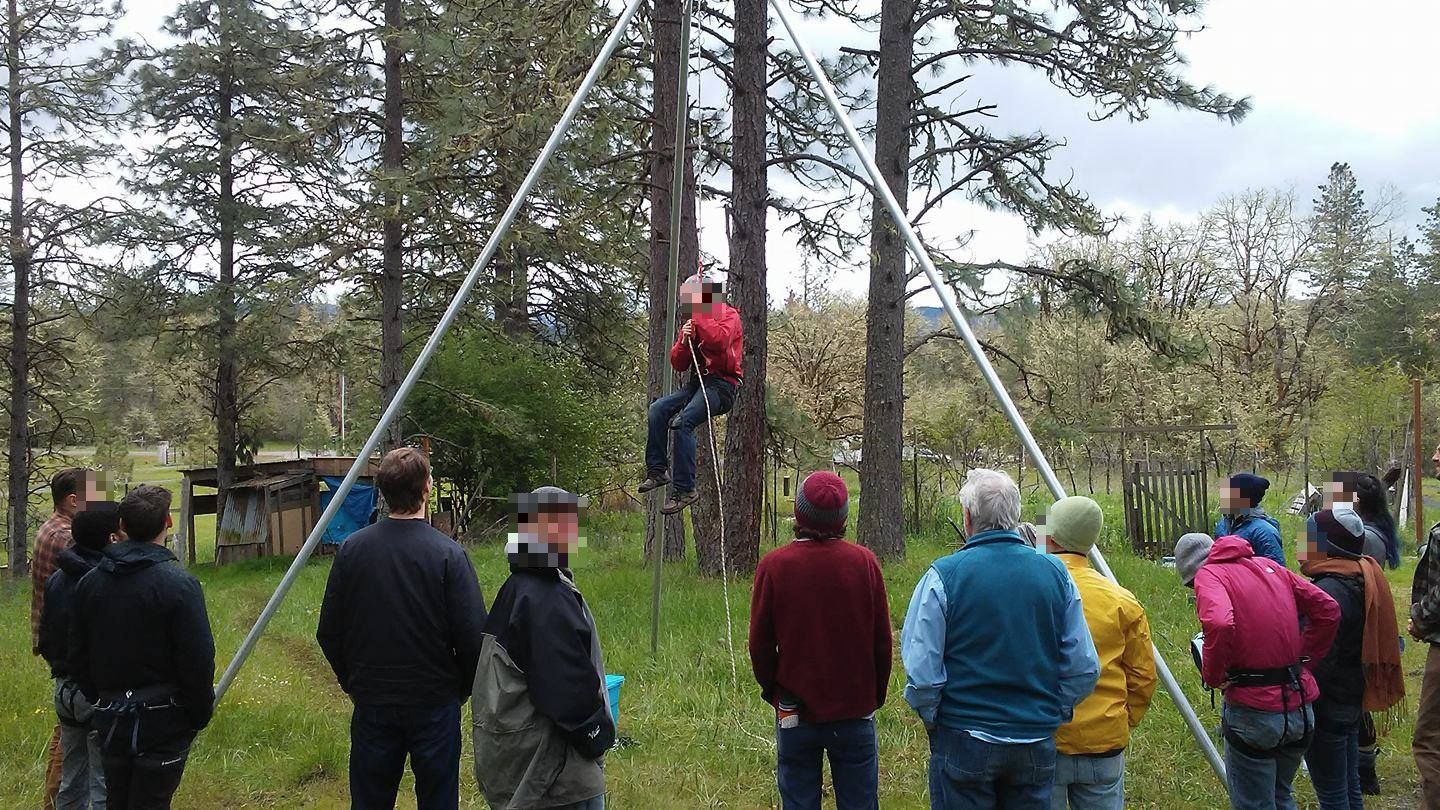
by DGR Editor | May 2, 2017 | Education
by Deep Green Resistance Eugene
Over Earth Day weekend, Deep Green Resistance members in Oregon hosted an advanced direct action training in rural western Oregon.
About 45 people attended from several surrounding states.
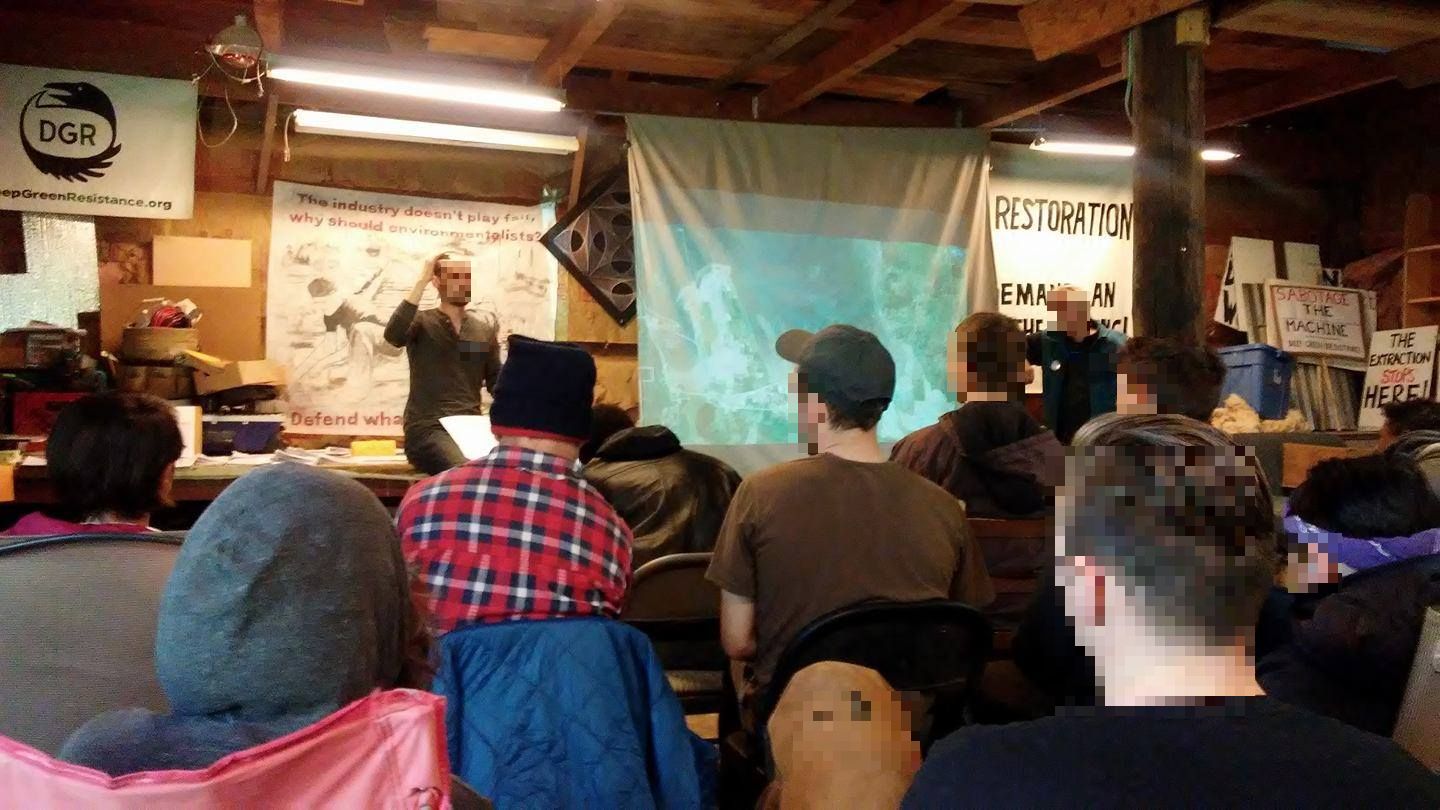
This workshop broke down critical factors and possible improvements for various recent and historical resistance actions and campaigns.
The training began with several anti-oppression sessions to help foster an equitable and safe environment for facilitators and participants, especially for people of color, women, indigenous people, and members of other oppressed and marginalized groups. These sessions, which included an introduction to radical feminism and a group activity around understanding privilege, aimed to inform the interpersonal dynamic and content of the training. This is also to help facilitate a more inclusive and comfortable organizing experience in our communities.
Other training sessions included:
• Campaign strategy
• Target selection
• Case studies in two recent direct actions from people involved in them
• Analysis of critical factors in other recent and historical resistance campaigns / actions
• Scouting for action
• Know your rights and legal briefing
• Art and resistance
• Media
• Various hard skills for blockades and direct action
• Communications and digital security
• Affinity groups
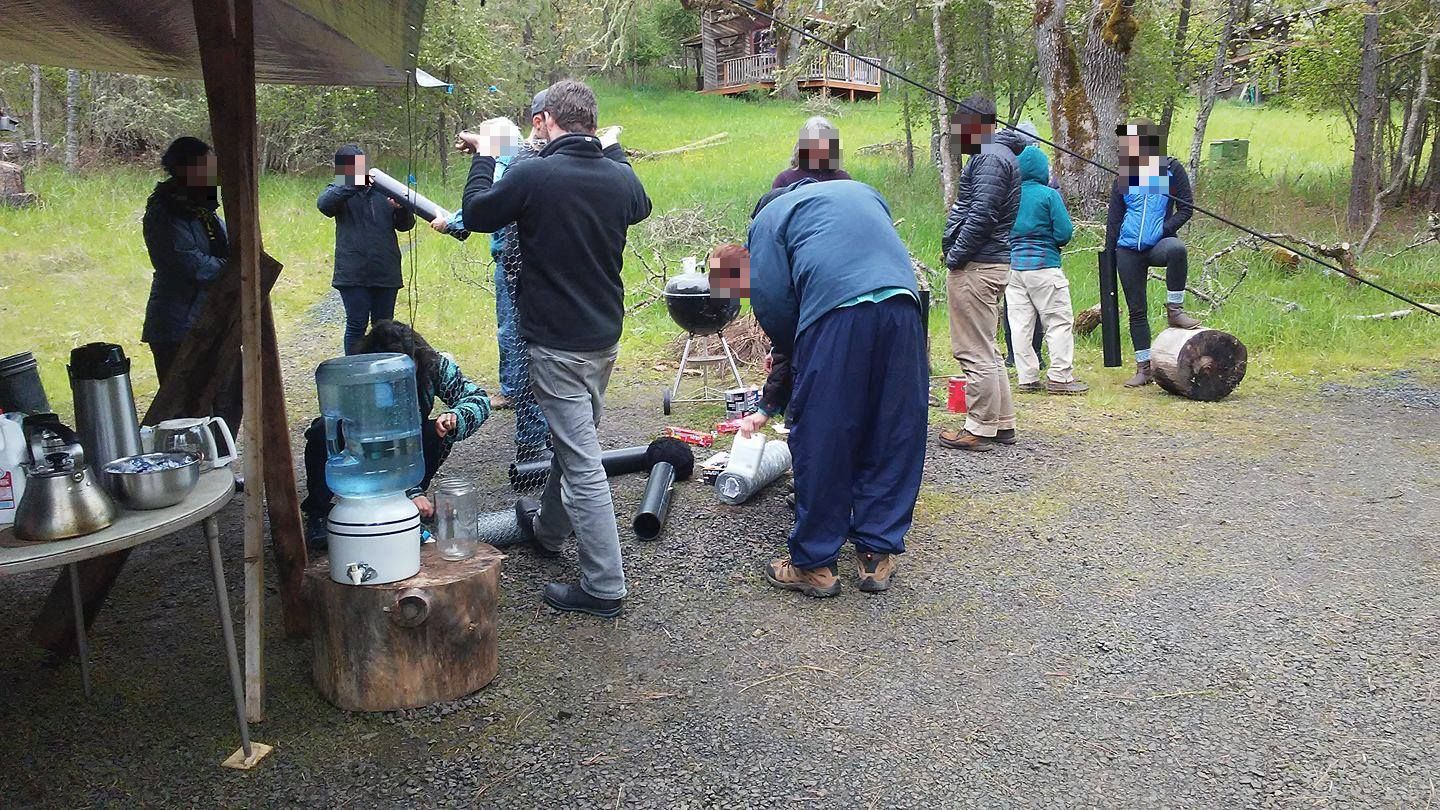
Experimentation with building materials for blockades.
Trainings like this play an important role in developing two critical elements in effective resistance: community and skills.
This sort of event would be impossible without financial support. To everyone who donates to Deep Green Resistance, is a monthly sustainer, or purchases gear from our website—thank you!
A few comments from attendees:
“Thank you… for such a comprehensive training in just a few days!”
“I considered not coming when I saw some militant photos on the DGR website, but I’m so glad I did. This training really debunked the myth of resistance activists being casually militant and violent people.”
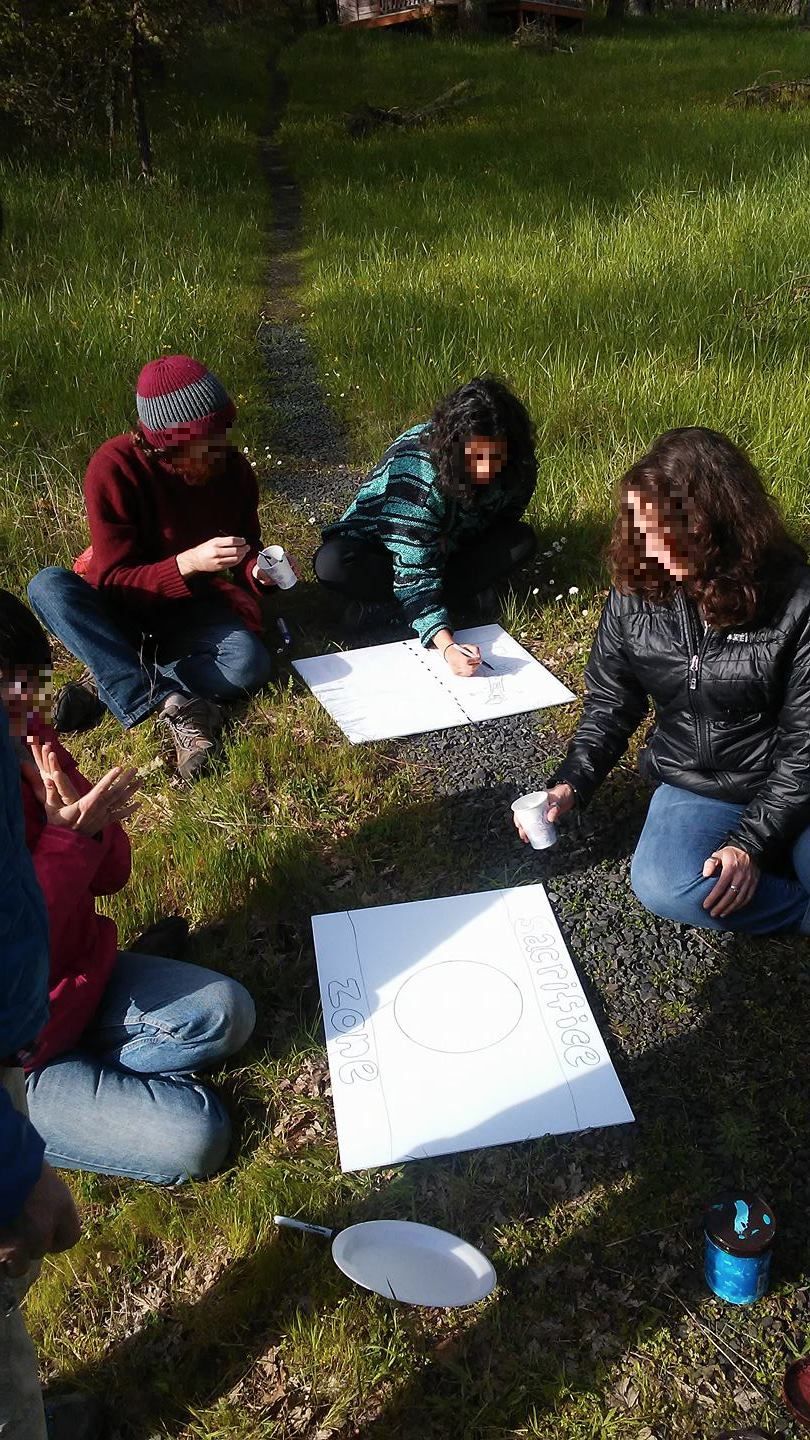
Artistic workshop after a long day sitting down inside.
“My daughter has been telling me for years about radical feminism and I never understood what she was talking about. I do now, somewhat, and I am aware of all I don’t know and hadn’t considered in terms of the climate crisis and potential steps I can take. I’m so glad I came.”
“I could spend weeks hearing and discussing the topics brought up on Saturday morning, and I learned a lot. The Privilege Walk was powerful and a great way to start the weekend. Thank you for the RadFem reading list and the matter-of-fact presentations on intersectional oppressions!”
“Awesome group of people at the training.”
“I’m home and full of inspiration… You have my deepest appreciation for the hours of hard work it took to make this weekend happen. The whole crew of you are simply wonderful, thank you for being dedicated enough to take bold actions and wise enough to do them prudently.”

Tripod and rope ascending workshop.
“The DA training offered an invaluable opportunity for DGR members and allies to meet in person, share ideas and skills, and build real community. Each new relationship felt like a door opening to our greater collective potential and previously unconsidered ideas. There is something magical in spending time together that cannot be quantified or explained. I can’t wait for the next get together and to see the inspiring ideas and actions that will surely come out of this training.”

by Deep Green Resistance News Service | Apr 29, 2017 | Education
by Max Wilbert / Deep Green Resistance Great Basin
As a kid, I pictured Nevada as a wasteland of sand and cacti. Today, I know better.
For the past five years, I’ve been packing up my truck every spring and taking a long day to drive to eastern Nevada to bask in the glory of one of the least densely-populated areas of the United States.
The broad valleys never fail to stun me, but most amazing are the mountains, limestone peaks arcing into the sky. Springs and creeks flowing from the hills support rich riparian zones and bring in birds and other wildlife from miles around. Antelope, deer, elk, and wild horses cross the valleys or stick to forested patches. This region is lush, biodiverse, and beautiful.
It’s also under threat. Across eastern Nevada, the Southern Nevada Water Authority seeks to build dozens of massive groundwater wells and pump almost every drop of water south to feed Las Vegas developments. The project has been a battle between locals and developers from Vegas for decades, and still drags on.
Another major threat is felling pinyon pine and juniper forests across not just this region, but the entire intermountain west. Ranchers have been doing this for decades to remove pesky trees getting in the way of their grass—and more importantly, their profit. As overgrazing continues to desertify Nevada—it’ll look like Iraq in another 100 years—removing trees allows ranchers to maintain the illusion that overstocking can continue indefinitely.
Countless people, including myself, are mobilizing to fight like hell for this land, this water, and these forests. We aim to stop these destructive projects by exposing their true nature and—if necessary—standing in their way.
There is a lot more to these stories, but I don’t have time to share it all here. Instead, I’d like to invite you to join myself and other community members, indigenous people, activists, ecologists, photographers, and families for the fifth annual Sacred Water, Sacred Forests Camp.
The camp takes place over Memorial Day weekend, May 27 to 29, near the town of Ely and Great Basin National Park. If you’re interested in attending, you can RSVP on the Facebook event page or by emailing greatbasin@deepgreenresistance.org.
I hope to be able to introduce you to this important, imperiled area in a few weeks.
—
Max Wilbert is a community organizer based in western Oregon who considers Nevada a second home.

by Deep Green Resistance News Service | Apr 25, 2017 | Lobbying, NEWS
Featured image: Fracking well. The damage that causes earthquakes seems to occur after the drilling, when the wastewater is injected deep underground, stimulating existing fault lines. Indigenous and other communities want Colombia to join France, Germany, Scotland and Bulgaria in banning fracking. By Thinkstock.
by Rick Kearns / Indian Country Today Media Network
Fracking is coming to indigenous Colombian territories and other parts of the country, and activists are trying to halt the process.
The controversial process known as fracking, short for hydraulic fracturing, involves injecting water, sand and various chemicals at high pressure into subterranean rocks, so as to force open existing fissures and extract oil or gas.
Environmentalists, scientists and others around the world have asserted that fracking can contaminate surface water and subterranean aquifers and has been linked to earthquakes and low birth rates among other things. At least four countries – France, Germany, Scotland and Bulgaria – have banned fracking and other countries and regions are considering similar measures.
On March 22, close to 40 environmental organizations, trade unionists and land defenders known as the Alliance for a Colombia Free of Fracking sent a public letter to Colombian President Juan Manuel Santos, asking him to issue a moratorium on fracking due to it’s potential harm to the environment and to thousands of Indigenous and other Colombians living near the wells.
According to an April report, the Colombian government had granted 43 gas and oil concessions to various corporations including multinationals such as ExxonMobil. ConocoPhillips and Drummond Ltd.
The activists note in the letter that fracking has been associated with increased seismic activity. They point to a study showing how wastewater fracking wells in Oklahoma cause a dramatic increase: from 50 seismic events at a level of 3 in 2010 to 400 level 3 earthquakes in 2014, an 800 percent jump.
“And in terms of public health,” the Alliance letter continued, “there are studies from the U.S., Canada and the European Union that connect the proximity of people to the areas where fracking activities are carried out with cases of neural tube alterations (The neural tube is the structure in the embryo that ultimately forms the brain and spinal cord), births with low birth weight, other birth defects and an increase in the incidence of congential heart problems.”
The activists asserted that “there is evidence that emissions from wastewater fracking wells can travel through the air to residential zones where they can cause asthma…”
Some of the fracking areas overlap with Yupka, Wiwa and Wayuu territories and activists have noted that these projects would violate the land rights of these Indigenous Peoples and potentially others.
While none of these communities have issued press statements regarding fracking, two of the largest Indigenous organizations have identified the process as a serious problem in past reports.
In September of last year, the National Indigenous Organization of Colombia (ONIC) published a statement by the allied Association of Indigenous Councils of Northern Cauca (ACIN) about the peace process between the government and the FARC guerillas. In that statement they pointed out that the Indigenous communities were worried about the government’s policies involving “extractavism” and “fracking” and the lack of prior consultation of the communities which is against Colombian and international laws.
In response to the recent developments the Alliance group known as the Corporation for the Defense of Water, Territory and Ecosystems (CORDATEC) held a two day conference on April 19 and 20 on “The Social-Environmental Impact of Fracking” in an area already affected by gas exploration.
Among the panel topics at the conference were “Environmental Impact” and “Resistance and Social Conflicts.”
As of press time President Santos had not publicly responded to the letter from the Alliance.
Photo by Brad Weaver on Unsplash
by Deep Green Resistance News Service | Apr 24, 2017 | Strategy & Analysis
Featured image: RCMP in riot gear during raid on anti-fracking blockade, Mi’qmak territory, Oct 17, 2013. From Warrior Publications.
This is the twenty-first installment in a multi-part series. Browse the Protective Use of Force index to read more.
via Deep Green Resistance UK
The destruction of our world isn’t an “environmental crisis,” nor a “climate crisis.” It’s a war waged by industrial civilisaton and capitalism against life on earth–all life–and we need a resistance movement with that analysis to respond.
I spent years as a liberal environmentalist, believing the propaganda from the state and the mainstream environmental movement that change will come about through top down solutions and technology fixes. Well, look where that’s got us – increasing destruction of the biosphere, accelerating species extinction and repeated failures of climate negotiations that are sold as successes.
When I finally understood that this approach wasn’t going to work, I got involved with the UK climate movement, but was unconvinced of their strategy and tactics. I respected the work being done but it looked hopeless considering the scale of the problems and the system causing them. In 2012, I read the Deep Green Resistance book. The book proposed a resistance movement forcing a crash of industrial civilisation and ending ecocide that made far more sense to me than anything else being offered. A strategy that is appropriate to the scale of the problem.
I see this response as self defence, or counter-violence. What is counter-violence? Frantz Fanon in The Wretched of the Earth coined the term to mean the violent, proportional response by colonised people to the coloniser’s violent repression. It has since been used more generally to refer to by any group’s use of force in response to state violence. [1]
Other terms for this response might be ”protective use of force,” “holistic self-defence” [2] or “defensive violence.” I find these ideas a relevant and useful way to frame how to respond to the destruction being inflicted on our world by industrial civilisation.
Self-defence actually discourages aggression and is a much better principle to use as a starting point than nonviolence. The definition of self-defence, agreed after thousands of years of experimentation, is that you can use the necessary amount of force to end an attack. Self-defence is a right and duty; a community that does not defend itself against aggression encourages further aggression. If aggressors are willing to kill or hurt anyone who gets in their way when taking what they want, there is little that those that practice nonviolence can do.
Most resistance movements in history have resorted to the use of force in response to the violence directed against them. They are simply defending themselves against violence by governments or the state. Mike Ryan articulates this well: “We accept the necessity of armed struggle in the Third World because the level of oppression leaves people with no other reasonable option. We recognize that the actions of Third World revolutionaries are not aggressive acts of violence, but a last line of defense and the only option for liberation in a situation of totally violent oppression.” [3]
So if freedom fighters in less industrialised countries are considered justified by many in using force against oppression, then why not in the industrialised world? Why not sabotage industrial infrastructure, if it amounts to self-defence? Perhaps because our conditioning to not act is too strong–we are too comfortable and have too much to lose. And therefore our collective inaction admits our participation in the oppression of other people.
When thinking about self-defence, we first need to be clear on what we mean by violence: Is fracking, deforestation, the damming of rivers, factory farming and the trawling of oceans violence? We also need to ask if non-humans who use force to protect their habitat, pack or family are violent? Your answers to this questions will affect if you think humans acting in self defence of their home or people are justified. [4]
Self-defence is a right we must reserve for ourselves. It we do not, then we invite violence attacks on ourselves, our families and our communities. Self-defence is the only thing that keeps violent institutions in check. It must also be combined with genuine solidarity with all non-human and humans under attack.
Assata Shakur, founding member of the Black Liberation Army and former Black Panther, clearly understood the need to fight back against the FBI and police who were killing black liberation leaders and activists. [5] Following the shooting of two New York police officers she said: “I felt sorry for their families, sorry for their children, but I was relieved to see that somebody else besides black folks and Puerto Ricans and Chicanos were being shot at.” [6]
The US communist Angela Davis describes how any revolutionary movement focuses on the principles and goals it is aiming to achieve, not the way they are reached. She described how society’s systemic or structural violence is on the surface everywhere, so is going to lead to violent events.
The former Black Panther Kathleen Neal Cleaver describes how the systematic violence against people of colour in the form of bad housing, unemployment, rotten education, unfair treatment in the courts–as well as direct violence from the police–led to the Black Panther Party forming to defend themselves.
I feel a deep sadness for what is happening to living beings and the natural world. I have been so well trained and conditioned by this culture that I struggle to really feel angry about what is happening. I think feeling angry is the appropriate response. We need to stop being so polite and positive, and connect with our anger about the destruction that is taking place. People alive now will be measured by those that come after by the health of what’s left of their landbases. [7] What matters is being effective, not moral purity about using only nonviolent tactics. We need a new Three R’s; instead of Reduce, Reuse, Recycle, they should be Resist, Revolt, Rewild. [8]

The two main arguments against using force or violence are that it is morally wrong and ineffective. The moral question needs to be reframed. Instead of judging if an act of force in an isolated situation is justified, we need to ask what actions are necessary to ensure the least amount of suffering to living beings overall. This means seeing ourselves as connected and as part of nature, and then acting in defence of life. To quote Mark Boyle: “We need to defend the Earth with the same ferocity we would evoke if it were our home, because it is. We need to defend its inhabitants with the same passion as if they were our family members, because they are. We need to defend our lands, communities and cultures as if our lives depended on it, because they do.” [9]
There isn’t any one strategy or tactic that is necessarily more effective than another. It depends on the circumstances. Those that advocate the use of force certainly don’t argue that it’s a more effective tactic and that nonviolence should never be practiced. [10] To think that violence is not effective is deluded. Clearly violence is effective because that is what the state uses. Of course, the ends achieved through undesirable means may not themselves be desirable. Also most revolutionary and decolonisation struggles have involved nonviolent and counter-violence movements working in tandem. [11]
Bowser writes:
There is a very simple activity you can do to examine your own relationship with nihilism and resistance. Picture somebody you love deeply…Next, picture that person being viciously beaten to death by a gang of heavily armed policemen and soldiers…who are virtually undefeatable. What would you do?
The voice of nihilism, the cry of fears says, “It’s hopeless, you could never stop the beating, they all have guns and weapons and you only have your fists. Besides stopping the beating is illegal, and you don’t want to break the law, do you? Just stand there, try not to look, and be grateful that it isn’t you.”
The voice of resistance, the cry of love, says “I don’t care what the odds are or who says what is illegal, I have to do everything in my power to fight to defend what I love. I must spend all my energy and effort attempting to stop this horrible thing, even if it’s the last thing I do. I must fight to resist this atrocity, or I am not worthy of this person’s love.” [12]
I think that most would fight to defend their love ones, although some may be too damaged by this culture to do this. Ultimately we need to ask “What do you love and what are you willing to fight for?”
This exercise also brings up an important point about legitimate and illegitimate use of force or violence. The state likes to pretend that its use of violence is legitimate against foreign states, “terrorists,” or its own citizens. But in fact there are no legitimate governments in existence in the world. They all exist because they or their predecessors conquered an area and now dominate it with the use of, or threat of the use of, violence. “Government” by its very nature isn’t legitimate. It exists to concentrate wealth for the few at the expense of the many. We need to look to indigenous people to see how people can be organised in a legitimate way–small human-scale groups (about 100 people), where they choose their own leaders, have a council or elders and are committed to living in balance with their landbase.
Indigenous societies would not understand the modern legalistic view of “violence” or the state’s exclusive claim on violence. Violence (or the use of force) is something that has been taken from us and it is something we need to take back. [13]
Sakej Ward is Mi’kmaw (Mi’kmaq Nation) from the community of Esgenoopetitj (Burnt Church First Nation, New Brunswick). He speaks regularly on the resurgence of Indigenous Warrior Societies which act in defence of the land. On the topic of violence he explains that when you have an empire, you need a monopoly on the legitimate use of violence. If citizens act in self defence, the state will classify this as illegal violence. The state will use violence and consider this a legitimate idea of the rule of law. He believes it’s very important to reject the imperialist notions of this monopoly on violence, that we should all be able to say “I can defend myself.”
This is the twenty-first installment in a multi-part series. Browse the Protective Use of Force index to read more.
To repost this or other DGR original writings, please contact newsservice@deepgreenresistance.org
Endnotes
- See Chris Hedges’ recent article http://www.truthdig.com/report/page4/the_great_unraveling_20150830
- Drinking Molotov Cocktails with Gandhi, Mark Boyle, 2015, page 6
- Pacifism as Pathology, Ward Churchill, page 1998, page 147
- Drinking Molotov Cocktails with Gandhi, page 31-2
- Assata: An Autobiography, Assata Shakur, 1987, page 349
- Assata: An Autobiography, page 339
- Endgame Volume 2: Resistance, Derrick Jensen, 2006, page 731
- Drinking Molotov Cocktails with Gandhi, page 23
- Drinking Molotov Cocktails with Gandhi, page 127
- How Nonviolence Protects the State, Peter Gelderloos, 2007, page 6, read online
- Pacifism as Pathology, page 89-91 and The Wretched of the Earth, Frantz Fanon, 1961, page 27-29
- Elements of Resistance: Violence, Nonviolence, and the State, Jeriah Bowser, 2015, page 33, read online
- Introduction to Civil War in journal Tiqqun, pages 34 and 46, read online
To repost this or other DGR original writings, please contact newsservice@deepgreenresistance.org

by Deep Green Resistance News Service | Apr 22, 2017 | Lobbying
Featured image: Residents of Kiad around an important boundary post for the Ngäbe people at the border of the comarca. (Photo courtesy Duiren Wagua)
Este artículo está disponible en español aquí
by Tracy Barnett / Intercontinental Cry
Cultural Community of Kiad, Panama — Members of the grassroots indigenous Ngäbe-Buglé group known as The April 10 Movement (El Movimiento 10 de Abril, or “M10”), issued a call to the international community on Wednesday. They ask for an intervention to stop Ngäbe-Buglé communities from being flooded by the Barro Blanco hydroelectric dam.
The M10 called the flooding illegal and a violation of their human rights and the UN Declaration on the Rights of Indigenous Peoples. They refer to an environmental impact statement that failed to acknowledge the presence of the three communities that would be flooded by the project. They also say the agreement that Panamanian President Juan Carlos Varela signed last August with the now-impeached leader Silvia Carrera was illegal, since it was done without the approval of the Ngäbe-Buglé General Congress, and was rejected by the congress in September.
Government representatives met with members of the group in the Cultural Community of Kiad on March 27. It was part of a series of meetings “to agree on options with respect to spaces and points of cultural veneration by communities impacted by the project and the monitoring of water quality studies,”[1] according to an institutional response from the government. Several days later, the water began to rise in the reservoir and has continued to rise until the time of publication of this communique. Community members have still not received communication from the government regarding the rising water levels or a future meeting date.
Communiqué from the April 10 Movement on the Barro Blanco hydroelectric plant
The community affected by the Hydroelectric Project Barro Blanco, hereby makes public the following facts of the violation of human rights by the Barro Blanco Dam:
1- As has been public knowledge since the beginning of the Barro Blanco project, the environmental impact study denied the existence of the original community that for centuries had lived in the confluence of the Tabasará River, and concessioning this place for the Barro Blanco hydroelectric dam has created a social, economic, cultural, spiritual, and environmental conflict for the community.
2- The government and the Supreme Court of Justice have violated the constitutional and legal precepts of our rights with the implementation of the Barro Blanco hydroelectric plant.
3- We firmly reject the ratification of the Varela-Carrera agreement for the defunct congress presided over by Demecio Case, held between 6 and 9 April 2017 in the northern community in the ñökribo region, in which agreement we played no part. Nor were we consulted about the content of the agreement, and the agreement was not accepted by the population of Llano Tugrí on August 22, 2016 and was rejected in Cerro Algodón on September 15, 2016 by the full General Congress where 148 delegates attended.
4- The highest body of expression and decision, the General Congress, has 255 elected delegates, with full right of decision and for which quorum constitutes 50% plus one; therefore the Norteño decision is illegal, since only 61 delegates attended, in addition to Mr. Demecio Case, who was removed from office on March 7, 2017, in Llano Tugrí, in the ordinary congress.
5- We request the President of the Republic to be a little more respectful of our rights, since any act carried out for the execution of said project has been done violating our legal security, and not only has violated the norms of the Republic, but also violated the Convention and the United Nations Declaration on the Rights of Indigenous Peoples.
6 – We call on the Panamanian population to protect the rights of all before the imposition of the government who makes use of economic and political power and interferes in the decision of the full Congress through the dismissal of Silvia Carrera and Demecio Case.
7- We make an urgent appeal to the national and international solidarity organizations and the United Nations to intervene to protect our rights as peoples most vulnerable to deserved justice in the Republic of Panama.
Gäejet Miranda
President of the M10 movement
Ngäbe-Büglé Comarca
Kiad Cultural Community, April 16, 2017
by Deep Green Resistance News Service | Apr 21, 2017 | Strategy & Analysis
by Will Falk / Deep Green Resistance
In my essay, Park City is Damned: A Case Study in Civilization, I described the vicious cycle Park City, Utah is caught in and explained how the city cannot exist for much longer.
There are far more humans in Park City than the land can support, so the necessities of life must be imported. Importing these necessities costs money and requires an industrial infrastructure. Park City makes its money through a tourist industry that relies on snow, but climate change, produced by the same industrial infrastructure bringing the necessities of life, is destroying the snow. The industrial infrastructure must be dismantled to stop climate change so the snow may survive. Either the snow or the industrial infrastructure will fail.
And, Park City will, too.
Not long after the essay was published, I attended a gathering for an emerging group PCAN! or Park City Action Network. The gathering’s goals included to “create a network for young professionals and build community, to learn what’s going on in local politics, and to find other like-minded individuals to create a strong collective voice.”
I think I’m still young (turned 30 in March), I have a law degree and license (in Wisconsin), and I’m interested in finding like-minded individuals to create a strong collective voice, so I went.
A man approached me, and said. “You’re Will Falk, right? You wrote that article?”
I was embarrassed and nervous people were going to hate me for what I wrote. But, his eyes and body language were sincere, so I told the truth. He asked, “So, you think Park City won’t last?
“Can’t physically last,” I clarified.
“ Right. And, solar power isn’t the answer? Wind power, either?”
“No,” I responded. He looked at me earnestly for a few seconds, looked around at the room of concerned, young professionals, and said, more to himself than to me, “Park City is still damned huh?”
“Still damned,” I said. He sighed and asked,“What the hell have we been working on all this time?”
I shrugged. I wasn’t sure what to say, but I could see acceptance in his face. I simply tried to meet his gaze. Finally, he asked, “What can I do?”
***
Park City’s vicious cycle is a reflection of the vicious cycle the global human population is caught in. There are far more humans than the planet can support sustainably, so the necessities of life must be stolen from non-humans and the future. This theft is managed through an industrial infrastructure powered by fossil fuels and the operation of this infrastructure is destroying the planet’s total life-supporting capacity. It is pushing the climate to temperatures too warm for most species, pushing oceanic life perilously close to total collapse, and contaminating, with toxins and carcinogens, the bodies of every civilized individual.
Unfortunately, with more than half the global human population now living in cities, most humans depend on this system for food, for clean water, and for shelter. Humans have backed themselves into a corner. If this system collapses, huge, urban populations of humans will be left without the necessities of life. But the system must collapse for the planet to survive. Ignorance of physical reality cannot save us from it; either the planet or the industrial infrastructure will fail.
Basic ecology gives us another way to understand this. In ecologic terms, humans have overshot the planet’s carrying capacity through dependence on a drawdown method of temporarily extending carrying capacity. Crash is inevitable, and the longer drawdown occurs, the smaller Earth’s total carrying capacity will be after the crash.
Humans are animals and, as animals, require habitat. Every habitat has a total life-supporting capacity, or carrying capacity. Carrying capacity is the maximum population of a given species which can be supported by a particular habitat indefinitely. Earth, even as the largest habitat, is finite with a specific carrying capacity.
In his ecological classic Overshoot: The Ecological Basis of Revolutionary Change, Dr. William R. Catton Jr. explains that civilized humans “have several times succeeded in taking over additional portions of the earth’s total life-supporting capacity, at the expense of other creatures.”
Catton’s phrase “at the expense of other creatures” is a nice way of describing extermination. Using 1970 population totals and current trends, the World Wildlife Fund recently published a prediction that by 2020 two-thirds of the Earth’s total vertebrate population (mammals, birds, fish, amphibians, and reptiles) will have been killed by human activities. Biologist Paul Ehrlich, who studies population at Stanford University, says that half of all individual life forms humans are now aware of have already disappeared.
Civilized humans have learned to rely on technologies that augment human carrying capacity in temporary ways. These augmentations are necessarily temporary because the finiteness of every habitat places physical limits on population growth. In other words, you can’t steal more than everything.
The latest and deadliest of the technologies humans have used to augment carrying capacity revolve around the exploitation of the “planet’s energy savings deposits, fossil fuels.” Through these exploitative technologies powered by fossil fuels, Catton argues, civilized humans are now engaged in a “drawdown method of extending carrying capacity.” This method is “an inherently temporary expedient by which life opportunities for a species are temporarily increased by extracting from the environment for use by that species some significant fraction of an accumulate resource that is not being replaced as it is drawn down.”
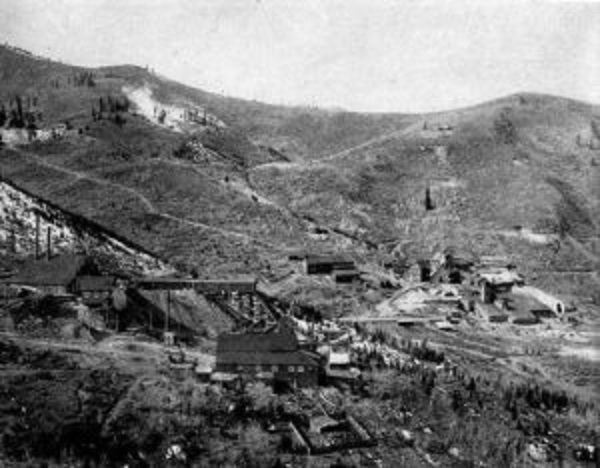
Daly West and Quincy Mines in Park City (circa 1911) / Wikimedia
This drawdown has allowed humans to overshoot the planet’s carrying capacity. Overshoot leads to a situation where a portion, or even all, of a population cannot be supported when temporarily available, and finite, resources are exhausted. When these resources run out, crash inevitably follows.Civilized humans are destroying countless so-called “resources” that are not being replaced as they are murdered. The extraction of fossil fuels is an easy example. But, civilized humans are also cutting forests and plowing grasslands faster than they can grow back, they’re stripping topsoil faster than it rebuilds, and they’re heating the planet more intensely than life can evolve to keep pace.
Richard Heinberg, Senior Fellow at the Post Carbon Institute, describes what is happening as the ecological phenomenon known as “population bloom” in his book The End of Growth: Adapting to Our New Economic Reality. When a species finds an abundant, easily acceptable energy source (in our case, fossil fuels), its numbers increase while taking advantage of the surplus energy. Speaking to the inevitability of crash, Heinberg writes, “In nature, growth always slams up against non-negotiable constraints sooner or later…Population blooms (or periods of rapid growth) are always followed by crashes and die-offs. Always.”
Crash following overshoot is bad enough, but the problem doesn’t end there. If a population exists in overshoot for too long, drawing down too many of its habitat’s necessities of life, the habitat’s carrying capacity can be permanently reduced. To use simple numbers, start with a carrying capacity of 1000 humans. What happens if 1200 humans, then 1500 humans, then 2000 humans live on the land for too long? Or those original 1000 humans steal other creatures’ carrying capacity and convert it to human use?
That land base’s carrying capacity can be permanently reduced to 800 humans, 400, and so on, over time, all the way to zero. Eventually, the population will crash and that land base will never be capable of supporting humans, or any other life, again. This is as true for the carrying capacity of a small locale like Park City as it is for the carrying capacity of the whole planet.
The horror we live with comes into focus. Most human lives are made possible by a system that will collapse, and the longer that system operates, literally eating Earth’s total carrying capacity, the less chance other lives – human and non-human – have to continue existing.
We have two choices. We can live in denial, even as the evidence of the planet’s murder piles around us. We can anesthetize ourselves with the comforts produced by this insane arrangement of power. We can pray for our own death before the worst of the collapse happens. In short, we can do nothing.
Or, accepting responsibility as people who love each other, love our non-human kin, and love life, we can stop the industrial system from destroying our beloveds.
Once you’ve decided to stand on the side of life, the question becomes, How? How do ensure as much life as possible will survive the coming crash? How do we stop industrial civilization from permanently reducing the planet’s carrying capacity to nil?
***
Longtime environmental activists and writers Derrick Jensen, Lierre Keith, and Aric McBay created a concrete strategy for an effective resistance movement in their book Deep Green Resistance. They named that strategy “Decisive Ecological Warfare (DEW).”
Before you object to the term “warfare,” consider this: In the past, wars killed humans. Today, with human activities killing 200 species daily, we are engaged in a war where whole species are exterminated. We readily recognize the chemical warfare characterizing so many conflicts of the last century and, today, industrial processes create a reality where every mother on the planet now has dioxin, a known carcinogen,in her breast milk.
This is a war. And, we are losing. Badly. If we’re going to win this war, we need to act like a serious resistance movement.
DEW gives us a comprehensive strategy. It is centered on two primary goals. Goal 1 is “to disrupt and dismantle industrial civilization; to thereby remove the ability of the powerful to exploit the marginalized and destroy the planet.” Goal 2 is “to defend and rebuild just, sustainable, and autonomous human communities, and, as part of that, to assist in the recovery of the land.”
Disrupting and dismantling industrial civilization is primary. If industrial civilization is not stopped, then the second goal will be impossible. The land will be pushed past its ability to recover and there will be too few necessities of life left to support autonomous human communities.
Accomplishing these goals will involve five smaller strategies. First, resisters will “engage in direct militant actions against industrial infrastructure.” This may frighten some people and others may feel physically incapable of actions like these. If you can’t engage in these kinds of actions, the people who can will need your material support. In a place like Park City, steeped in privilege, the most obvious form of support the community could offer is money. Those in power are incredibly well-funded. We’ll never match them dollar for dollar. But, that doesn’t mean money can’t be put to good use.
Second, they will “aid and participate in ongoing social and ecological justice struggles; promote equality and undermine exploitation by those in power.” My friend Rachel Ivey, a brilliant feminist writer and organizer, often connects social and ecological justice with the truth that, “Oppression is always tied to resource extraction.” This means that industrial civilization has been built on the backs of people of color, indigenous peoples, the poor, and women. These groups are often on the movement’s front lines, fighting for survival. We must join them in true solidarity.
Third, they will “defend the land and prevent expansion of industrial logging, mining, construction, and so on, such that more intact land and species will remain when civilization does collapse.” Pipeline and port blockades, tree sits, and other forms of non-violent direct action aimed at physically preventing those in power from destroying more of the land is an essential piece of the puzzle. There are roles in the resistance for pacifists and others personally and philosophically unwilling to engage in more militant actions.
Fourth, they will “build and mobilize resistance organizations that will support the above activities, including decentralized training, recruitment, logistical support, and so on.” A serious resistance movement needs artists, writers, and those skilled in marketing and mass media communications. It also needs quartermasters, organizational psychologists, and others trained in logistical thinking.
Finally, resisters will “rebuild a sustainable subsistence base for human societies (including perennial polycultures for food) and localized, democratic communities that uphold human rights.” As collapse intensifies, we are going to need permaculturists, gardeners, and urban farmers to produce food when the industrial networks, currently transporting food, fail.
All kinds of skills will be necessary to stop industrial civilization, but the most important thing is that industrial civilization is actually stopped. All of our efforts must support this primary goal. Right now, the dominant system is barreling down a path that ends in total ecological collapse. Not only is the human species endangered with extinction, but every species – save, maybe a few microscopic species of bacteria – is threatened with annihilation. Before anything else, we must knock the dominant system off that path.
***
I return to answering the question, “What can I do?”
This is the wrong question. Don’t ask, “What can I do?” Instead ask, “What needs to be done?”
Go outside. Look around. Take a deep breath. Feel the oxygen, exhaled by trees, seep into your lungs. Let your breath go, and listen as the trees inhale the carbon dioxide your breath releases. Ask those trees what they need.
Climb to the top of the nearest hill. Find a boulder to sit on and wait. Match the land’s patience. Let gravity pull your bones closer to their ancestors, the bones of the earth. Watch the ants march, dutifully performing work for their community. Listen to the geese arriving for the spring, celebrating their return. Ask the stones, the ants, and the geese what they need. Ask them what needs to be done.
They’ll tell you they need to live.
The trees will tell you that warming temperatures cause cavitation, or bubbles, in the water flowing from their roots to their topmost leaves and that these bubbles kill them as surely as artery blockages kill humans.
The stones will tell you how quickly everything has changed. They will tell you how species they used to watch disappeared faster than stones, who exist on geologic time, can contemplate. They will tell you about mountain top removal, open-pit mining, and earthquakes caused by fracking.
The ants will tell you how they’ve long been involved in planetary cooling processes. They’ll show you how they’re working as hard as they can to build limestone by freeing calcium carbonate from minerals in the soil. And, in the process, trapping as much carbon dioxide as they can.
The geese will tell you of frantic searches for disappearing wetlands, of once wild rivers dammed, drying, and no longer flowing to the sea.
When you stop asking “what can I do?” to begin asking “what needs to be done?” it is true, you may expose yourself to a world in pain. But, you’ll also find countless allies asking the same questions you are. You may rip the scar tissue of denial that has been shielding your eyes from the near-blinding truth. But, once you let the sunlight in, once you step outside into the real world, you’ll open yourself to a world fighting like hell to survive.
We’ve been waiting for you.
Will Falk moved to the West Coast from Milwaukee, WI where he was a public defender. His first passion is poetry and his work is an effort to record the way the land is speaking. He feels the largest and most pressing issue confronting us today is the destruction of natural communities. He received a Society of Professional Journalists, San Diego Chapter, 2016 Journalism award. He is currently living in Utah.
To repost this or other DGR original writings, please contact newsservice@deepgreenresistance.org









